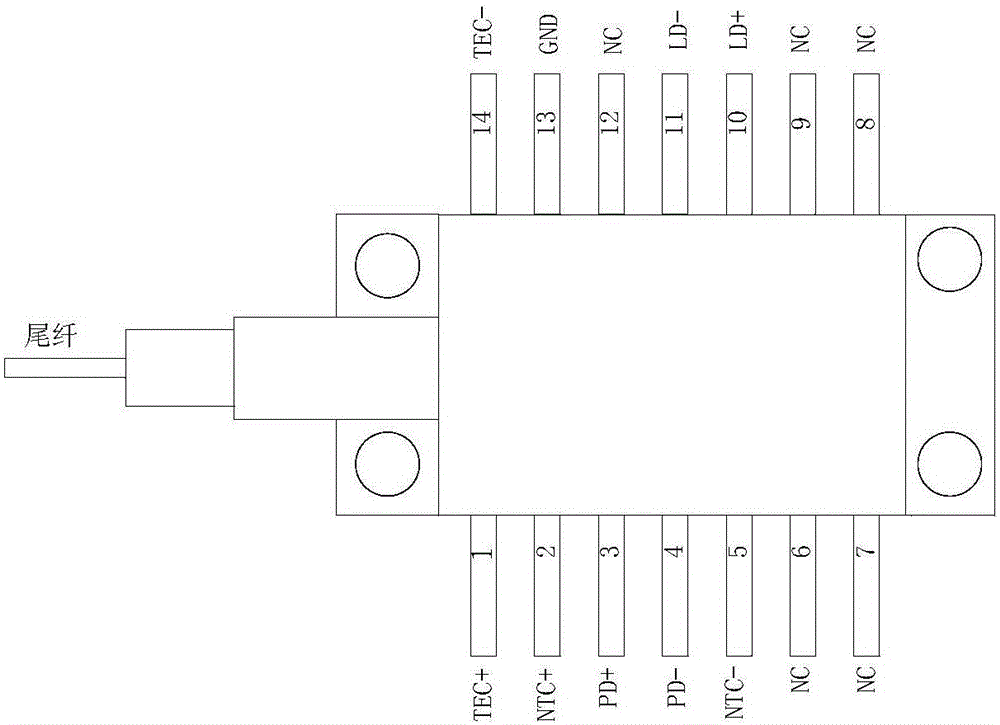High stability laser generating circuit based on PID control
A high-stability technology for generating circuits, applied to circuits, lasers, laser components, etc., can solve problems such as laser temperature rise, easy burning, output optical power oscillation, etc., to prevent damage to laser modules, prevent oscillations, and improve The effect of stability
- Summary
- Abstract
- Description
- Claims
- Application Information
AI Technical Summary
Problems solved by technology
Method used
Image
Examples
Embodiment 1
[0026] Embodiment 1 Overall structure of the system
[0027] Such as figure 1 As shown, the system structure has a laser module 1, a power control module 2 and a temperature control module 3, and the power control module 2 is composed of a power setting module 21, a power sampling module 22, a PID operation module 23, an LD driving module 24 and an overtemperature The power-off module 25 is formed, the power control module 2 and the temperature control module 3 are connected to the laser module 1, the power control module 2 provides the driving current to the laser module 1, the output optical power is controlled by the size of the driving current, and the power setting module 21 sets the required power (output in the form of voltage), and the power sampling module 22 samples the output optical power through the photodiode (PD) integrated in the laser module 1 and converts it into a voltage, and then the voltage set by the power setting module 21 is in the Carry out seeking d...
Embodiment 2
[0028] Embodiment 2 laser module
[0029] The laser module 1 of this embodiment selects the laser module of Jie Dixun LC96 butterfly package, and its package and pin schematic diagram are as follows figure 2 As shown, the laser module integrates laser diode LD, photodiode PD, thermoelectric cooler TEC and thermistor NTC. The module has 14 pins, including 6 pins, 7 pins, 8 pins, 9 pins, and 12 pins. Both are empty pins (NC). Pin 1 and pin 14 are the two current input terminals (port TEC+ and port TEC-) of the internal thermoelectric cooler respectively, which are used to connect with the current output port of the temperature control module 3. Pin 2 and Pin 5 is the two wiring ports (port NTC+ and port NTC-) of the internal integrated thermistor, which are used to connect with the thermistor input of the temperature control module 3, and the port NTC+ is also connected to the input of the over-temperature power-off module 25 Connected, pin 3 and pin 4 are the two wiring ports...
Embodiment 3
[0030] Embodiment 3 temperature control module
[0031] The temperature control module 3 described in the present invention is a prior art, specifically, Chinese patent CN2007100559129 (high-stability constant temperature controller) or Chinese patent CN2010102701027 (wide power consumption limitation based on thermoelectric cooler) applied by the applicant's research group type constant temperature controller), the temperature control module 3 has a set of current output terminals for driving the thermoelectric cooler for cooling or heating, and the temperature control module 3 also has a set of thermistor input terminals for connecting the thermistor. And the resistance value change of the thermistor (the change in resistance value reflects the change in temperature) is converted into a voltage change and fed back to the temperature control module 3 to realize automatic temperature control.
PUM
 Login to View More
Login to View More Abstract
Description
Claims
Application Information
 Login to View More
Login to View More - R&D
- Intellectual Property
- Life Sciences
- Materials
- Tech Scout
- Unparalleled Data Quality
- Higher Quality Content
- 60% Fewer Hallucinations
Browse by: Latest US Patents, China's latest patents, Technical Efficacy Thesaurus, Application Domain, Technology Topic, Popular Technical Reports.
© 2025 PatSnap. All rights reserved.Legal|Privacy policy|Modern Slavery Act Transparency Statement|Sitemap|About US| Contact US: help@patsnap.com



